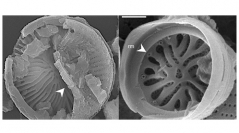

 European Journal of Taxonomy
726 (1) - Pages 1-23
European Journal of Taxonomy
726 (1) - Pages 1-23Several taxa of Stephanodiscaceae were found in the upper section of Pleistocene sediments from Lake Petén-Itzá (Guatemala). A new fossil genus Cyclocostis Paillès gen. nov. and new extant species Discostellagabinii Paillès & Sylvestre sp. nov. are described. Cyclocostis gen. nov. is characterized by a strongly tangentially undulated valve surface, coarse unequal striation reaching a central punctum in the valve center, an absence of central lamina and domed criba, widely open alveoli with one median recessed costa bearing marginal fultoportulae and a single rimoportula all within a ring. A single valve face fultoportula is present on the raised part of the valve opposite the rimoportula. Differences relative to similar genera and the delimitation of a new genus are discussed. Discostella gabinii sp. nov. is distinguished by circular and fl at valves, a small central area bearing 5 to > 30 scattered large areolae giving a colliculate appearance, medium-sized alveoli, marginal fultoportulae on every 4–5th costa, a single rimoportula and internally smooth valve center. Differences to similar taxa in the genus Discostellaare discussed. The succession of the species of Cyclotella, Discostella and Cyclocostis gen. nov. in our record could represent eco-phenotypic responses to particular environmental stress/change.